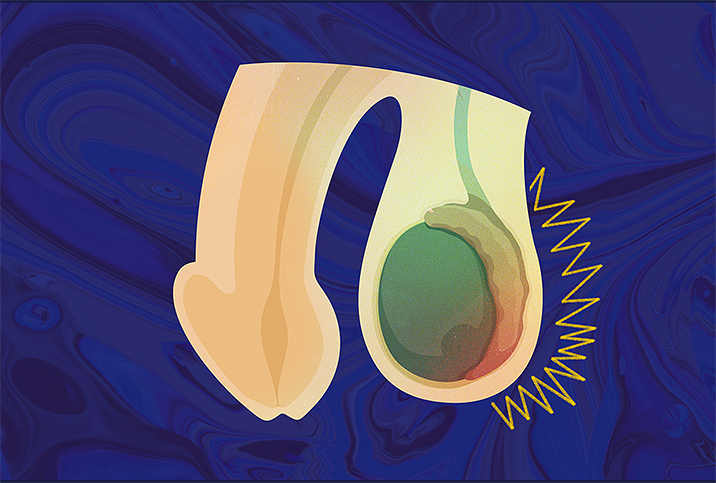5 Penis Conditions You Might Not Know

Most of the time, the human body is an amazing machine that carries out a lot of unnoticed self-maintenance. We cruise through our daily lives, ignoring minor issues because they usually resolve on their own—a runny nose, a pulled muscle, a canker sore.
But for people with a penis, when something goes awry down there, we take notice.
Oh, you betcha we do.
And a lot can go wrong. Some penis conditions are common, some aren't, but even some of the common ones aren't well known. Test your knowledge of these five conditions.
Paraphimosis
In infants and toddlers, phimosis is a fairly common condition in which the foreskin on an uncircumcised penis is too tight to allow it to be pulled back over the glans, or penis head. At least 10 percent of uncircumcised boys will have phimosis up to age 3, though as the foreskin stretches over time and becomes more pliable, the condition becomes less prevalent in older boys and men.
On the other hand, paraphimosis is a related but much more serious condition in which the foreskin becomes trapped behind the head of the penis and can't be pulled forward again. It's considered a medical emergency and can result in dangerously reduced blood flow.
"Paraphimosis is when the skin is retracted and gets stuck in that position," said David Barham, M.D., a fellow at the University of California at Irvine. "This creates swelling and entrapment of venous blood and ultimately a decrease in the inflow of arterial blood, creating ischemia and potential tissue death."
Translation: If this happens to you, get to a doctor fast, but only if you like your penis.
Pearly penile papules
No, the Pearly Penile Papules aren't an obscure punk band. (We checked.)
Pearly penile papules are white bumps that appear behind the penis head and are sometimes mistaken for genital warts. They may look alarming—especially in an age when we know so much about the relationship between genital warts, human papillomavirus (HPV) and some forms of cancer—but they're harmless.
"They can be confused as genital warts but have no relationship to HPV," Barham said. "These are white papules, or dome-shaped lesions, usually along the corona, which is the rim at the base of the glans, or head of the penis."
For people with a penis, when something goes awry down there, we take notice.
Pearly penile papules are generally not painful and don't require treatment, merely the patience to wait for them to go away on their own.
"They are benign and relatively common," Barham said, before adding, "It does seem like a great name for a punk band."
Lichen planus
If you're familiar with psoriasis, you have a head start on understanding lichen planus. As with its better-known cousin, psoriasis, lichen planus is an autoimmune condition that can cause a rash and discomfort.
Signs of oral lichen planus include burning or painful white lesions in the mouth. Much as with any affliction, it's worse when it's on the genitals. Lichen planus presents as a bumpy, itchy rash on the penis, along with other symptoms, such as:
- Purplish bumps that can spread beyond the genitals
- Blisters that sometimes fill with pus
- A pattern of lines on the rash
The autoimmune response of lichen planus can be triggered by allergies, viral infections and stress, as well as a genetic predisposition toward it. The condition is not contagious or generally serious.
Penile cancer
If ever there were two words as terrifying to men as "testicular cancer," they'd have to be "penile cancer." Luckily, penile cancer is rare in the United States, expected to be diagnosed in an estimated 2,210 new cases in 2021, according to the American Cancer Society.
"It's more common in countries where circumcision is not performed," said Jayram Krishnan, D.O., a urological oncologist with the Cleveland Clinic. "So one of the risk factors is being uncircumcised. The next main one is a history of HPV, and then the third one is smoking."
Symptoms can include:
- A red, velvety swath of penis skin on the shaft just below the head
- Small, crusty bumps or a rash that looks like a scab
- Changing skin thickness or color
- Bluish-brown growths
- A foul-smelling discharge beneath the foreskin
- Sores
- Swelling of the head
- Lumps beneath the skin in your groin
- Bleeding
"It would basically be any kind of lesion that's on your penis or scrotum," Krishnan said. "There are variants of HPV that are more associated with penile cancer than others: HPV 16 and 18. So if somebody has a history of HPV that they've had biopsied or removed, and we know it's that type, then we're a little bit more aggressive screening those guys."
If it's detected early, penile cancer can be treated with a cream or cryotherapy. However, later-stage options include radiation or—gulp—penectomy.
Yes, that means what you think it means.
Yeast infections
While it's true yeast infections are more common in people with vaginas, penis-havers are also susceptible to them.
Moisture on the skin of the penis—especially under the foreskin of uncircumcised men—can lead to an overgrowth of Candida. That's the fungus responsible for yeast infections, which can, in turn, lead to a condition called balanitis.
Some yeast infection symptoms include:
- Burning while urinating
- Penis skin that seems constantly moist
- An accumulation of a thick, white substance in the skin folds of the penis
- White, shiny patches on the penis
- Itching, redness or burning
Yeast infections are easily treatable using over-the-counter antifungal medications.
Keeping your penis clean may not be a 100 percent guarantee of keeping it healthy, but hygiene can go a long way. Wash regularly and change your underwear daily, especially after sweaty activities.
If you're uncircumcised, make sure you carefully dry the area under your foreskin to ensure your penis remains happy and healthy.


















